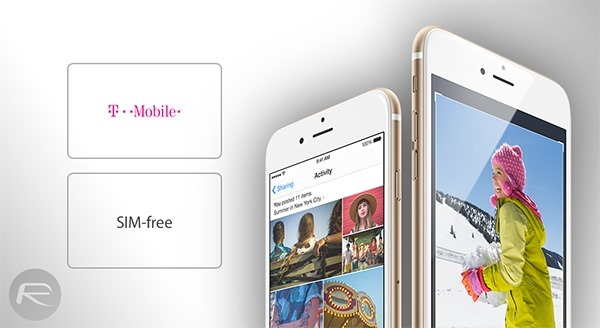Apple is finally selling unlocked SIM-free iPhone 6 and iPhone 6 Plus smartphones through its retail outlets and online store, along with the unlocked T-Mobile variant. What’s the difference between the two and which one should you go for? We’ll differentiate the two in detail, right after the jump.
On Apple’s website there are two models listed and being sold; first one is labelled ‘T-Mobile’, and the other one is ‘SIM-Free’. First up, both are fully unlocked. The T-Mobile version is obviously the one which comes with the carrier’s own nano-SIM card pre-installed, but the device is fully unlocked if bought from Apple, and hence can be used on any other network, anywhere in the world, including the United Sates, while the SIM-free unlocked model does not come with any SIM card, and just like the T-Mobile variant, is free to be used on any carrier.
The main difference lies in the bands which both the handsets support, and it can end up affecting your buying decision for which model you would want to go for, specially if you’re a frequent traveller overseas. For starters, there’s one model each of the iPhone 6 and iPhone 6 Plus for both T-Mobile and the SIM-free versions. They are as follows:
T-Mobile
- iPhone 6 (model A1549)
- iPhone 6 Plus (model A1522)
SIM-Free
- iPhone 6 (model A1586)
- iPhone 6 Plus (model A1524)
The model of your iPhone 6 or 6 Plus is written behind the box in which the device comes in.
T-Mobile iPhone 6 and iPhone 6 Plus
- The T-Mobile variant of the iPhone 6 and iPhone 6 Plus features bands which are more specific to the United States, therefore the handset will work just fine with most 4G LTE networks there.
- The T-Mobile version of the iPhone 6 and iPhone 6 Plus won’t work with China’s advanced TD-LTE network, so if you plan on going to China, getting the T-Mobile version isn’t a good idea.
- This model comes with T-Mobile’s SIM card pre-installed, and it’s the best option to go for if you’re in the United States or plan to stick with the carrier as your daily runner.
- T-Mobile’s iPhone 6 and iPhone 6 Plus will also work with most 4G LTE networks around the world, but it’s first always good to check which bands are supported by your network before you make the purchase.
- T-Mobile’s unlocked iPhone 6 and iPhone 6 Plus will work with the following carriers in the United States with full support for 4G LTE:
The bands and networks supported by the T-Mobile iPhone 6 and iPhone 6 Plus are as follows:
iPhone 6
iPhone 6 Plus
SIM-Free iPhone 6 and iPhone 6 Plus
- The SIM-free variant of the iPhone 6 and iPhone 6 Plus is the one which is tailored to be used pretty much anywhere in the world, with compatibility for 4G LTE capable carriers in various nations.
- This model also works on China’s advanced TD-LTE and TD-SCDMA networks, so you can rest assured that all the necessary bands are there when you get hold of the device.
- The SIM-free iPhone 6 and iPhone 6 Plus may not offer full compatibility with carriers in the United States, therefore you might be restricted to 2G or 3G on some popular networks.
- Unlike the T-Mobile version of the iPhone 6 and iPhone 6 Plus, the SIM-free variant does not come with any SIM card out of the box, and you have to purchase it separately.
- The carriers supported by the SIM-free models in the United States are as follows:
The bands and networks supported by the SIM-free iPhone 6 and iPhone 6 Plus are as follows:
iPhone 6
iPhone 6 Plus
Apple’s Take On The ‘Unlocked iPhone’
Here’s what Apple has to say on the unlocked iPhone on its very own website:
Conclusion
If you’re a frequent traveller then the SIM-free model of the iPhone 6 and iPhone 6 Plus is the way to go, since it supports all the necessary bands worldwide, but has some limitations when it comes to carriers in the United States. And if you’re living in the U.S. and aren’t bothered about going overseas, then the T-Mobile variant of Apple’s handsets is the logical choice.
Those looking to purchase Apple’s flagship smartphone, which will you choose given this information? Do share your thoughts with us below!
You can follow us on Twitter, add us to your circle on Google+ or like our Facebook page to keep yourself updated on all the latest from Microsoft, Google, Apple and the web.

